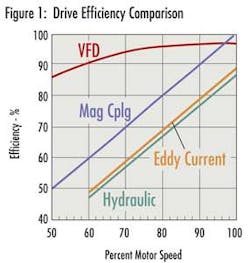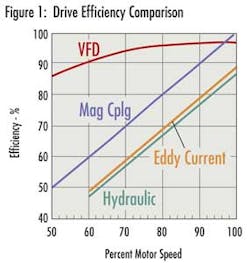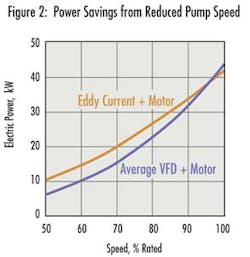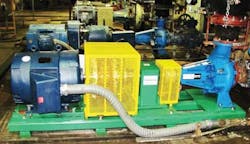Evaluating Adjustable Speed, Permanent Magnetic Coupling Drives
By Allan R. Budris
It is an indisputable fact that, for most applications, pump users can see substantial energy and maintenance costs savings by the use of a variable speed drive (VSD), instead of throttle valves, for pump flow control. However, the most common type of VSD, a variable frequency drive (VFD), cannot always be justified for financial and/or application reasons, as pointed out in the writer's March 2008 Pump Tips column.
Fortunately, there is a relatively new type of VSD that can get around many of the VFD (and other VSD type) negative issues, and that is the "Adjustable Speed Permanent Magnet Coupling", also called a Permanent Magnet Drive (PMD). Although the efficiencies of PMDs are somewhat less than for a VFD at moderate to higher speed turn downs, they can still save substantial energy and maintenance costs, and are quickly gaining market acceptance.
Advantages of all VSDs
All variable speed drives have definite advantages for pump users, if they can be justified.
- Large potential energy (cost) savings at reduced pump speeds.
- Increased life of the pump bearings, mechanical seals and impellers due to lower speeds and reduced suction energy.
- Elimination of the control valve (and associated losses), and any by-pass lines.
- Elimination of the inrush current on start up. Soft starting reduces the stress on the motor, pump, coupling and the supply network. This can also reduce peak demand electric rates.
- They can restart a spinning load.
Exclusive Advantages of VFDs
In addition to the general VSD pluses, variable frequency drives (VFDs), which are the most popular VSD type, have additional advantages not found in other VSDs, but these advantages do have to be balanced by some exclusive drawbacks, also listed below.
- They generate higher supply side power factors at all loads, unlike a constant speed motor, and this can reduce utility rates.
- They can provide system control logic, fault protection and diagnostics.
- They are the most efficient VSDs at reduced speeds (see figure 1).
Drawbacks of VFDs
Unique drawbacks of variable frequency drives are largely related to the choppy sinusoidal wave form generated by the VFD.
- A key drawback is the relatively high total initial cost of Variable Frequency Drives (VFD), especially on medium voltage applications, which can be further aggravated by the potential requirement to also replace the motor, and to address any resulting cable or impedance load reactor requirements.
- VFD drives can generate stray motor currents. This may require grounding of the motor rotor and/or the use of bearings with insulating coatings on the outer ring (found in VFD rated motors).
- VFDs may be forced to operate in the by-pass mode (maximum speed) when powered by an emergency generator.
Advantages Exclusive to PMDs
Permanent magnet drives (a type of eddy current coupling and VSD) have their own exclusive additional advantages, which in a growing number of cases can counter the exclusive VFD drawbacks, and the PMD's slightly lower efficiency at greater speed turndowns.
- They provide speed control at somewhat lower total cost than Variable Frequency Drives, especially at higher power ratings and medium voltages. However on low voltage applications, the cost of just the PMD may be as high as for the basic VFD drive, plus a new base-plate could be required for larger PMDs.
- The non-contact coupling feature allows it to tolerate higher gross parallel and angular shaft misalignment, and to not transmit vibration between the pump and motor. This can increase bearing and mechanical seal life in pumps and bearing life in motors.
- They retrofit easily to existing motors and drive systems (reducing capital cost). They do not require a motor replacement or special motors.
- They are mechanically simple.
Eddy Current (Magnetic Slip) Couplings
Two types of magnetic slip couplings are available in the industry, and they both function similarly. The earlier technology product being the eddy current coupling, is an electromechanical torque transmitting device. The original eddy current drives are very heavy and bulky, requiring extra infrastructure. They also have slightly lower efficiency due to the additional power required to energize the magnets. Permanent Magnet Drives (PMDs) are the latest technology product, and were introduced in the mid 1990s.
Both work on the principle of magnetic induction. Torque is generated as a function of slip (1% - 4% at maximum speed) between the input and output shafts. The primary difference between these two types of devices is how the magnetic field is generated. One uses high strength permanent magnets, and the other uses a field winding that is excited by outside direct current. The electrical power source is eliminated when using a PMD. They are typically cooled by convection into the surrounding air, making their heat capacity a function of ambient air temperature and rotating speed. Larger couplings do require water cooling to remove this heat.
Even though the efficiency of an eddy current drive is less than that of a VFD at lower speeds, the much larger energy saving from operating a pump at lower speeds still results in a substantial net energy savings for the eddy current driven pump, which is not that much less than for a VFD (see figure 2).
Adjustable Speed Permanent Magnet Couplings / PMDs
PMDs (see figures 3 and 4) replace the physical connection (coupling) between the motor and the pump, but with a gap of air. This gap eliminates harmful vibration, wear and tear, increases motor life, and protects the pump from overload damage. Power is transmitted across an air gap with the motor and pump completely disconnected. An actuator mechanism is included to adjust the air gap spacing between the conductor rotor and the magnet rotor, which varies the slip between the drive and driven load, thus permitting speed control. Due to the fact that these couplings vary speed by varying the motor slip, the efficiency is proportional to the speed turn-down. Automatic control is easy. The peak demand current and the duration of the inrush are also reduced significantly. This cushioned start results in further energy savings and reduced equipment wear. For many applications a lower peak current demand can also contribute to lower electrical power rates. Finally, PMDs offer accurate process control, shaft misalignment tolerance, and a variety of equipment mounting configurations. They are very popular with vertical pump applications.
As a result of these above features, the PMDis a strong competitor with most variable speed drive systems. PMD technology has one of the fastest adoption rates, quickly gaining market acceptance due to three overriding factors: a simple mechanical solution, ever expanding performance ratings, and retrofits that typically replace conventional coupling without drive modification. PMDs can handle loads up to 4,000 hp, although water cooling is typically required for power ratings above 500 hp to 1,000 hp.
Conclusions
While not all pump applications are candidates for variable speed drives, many are, and these applications have the potential for substantial energy and maintenance cost savings. However, as can be seen from the above, these savings may be difficult to justify due to high initial cost, and other issues with some types of Variable Speed Drives, especially the most popular variable frequency drives. However, if a conventional VFD cannot be financially justified for an application, it would be wise to also evaluate a PMD, before abandoning the potential advantages of a variable speed drive.
References:
1. "What You Must Know About Variable-Speed Drives," by Greg S. Highfill, P.E. (MagnaDrive Corp), Pumps & Systems, March 2007.
2. "Broader Definition of Pump-Drive System Efficiency Prompts Municipalities to Reconsider Drive Options," by Gary Garson, WaterWorld, April 2012.
About the Author: Allan R. Budris, P.E., is an independent consulting engineer who specializes in training, failure analysis, troubleshooting, reliability, efficiency audits and litigation support on pumps and pumping systems. With offices in Washington, NJ, he can be contacted via e-mail at [email protected].




